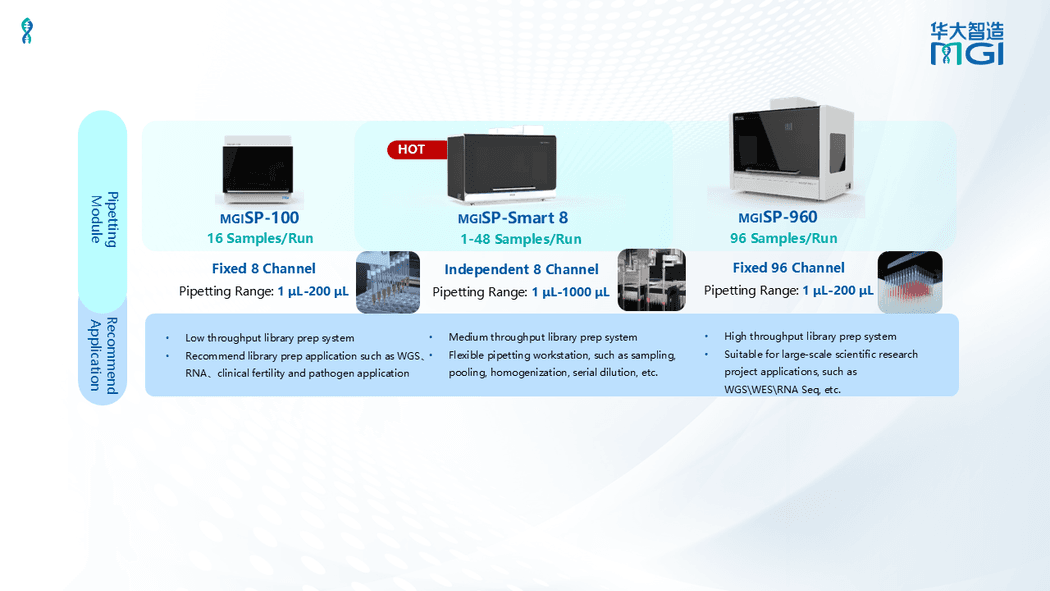Accurate, repeatable sequencing data depends on high-quality sequencing libraries, making library preparation a critical and often labor-intensive step, particularly for highly sensitive next-generation sequencing (NGS) protocols.
Library preparation is a common bottleneck for sequencing workflows, requiring both expert oversight and meticulous attention to detail. The highly repetitive nature of library preparation demands sustained focus on highly repetitive tasks due to the high impact of subtle errors or differences in technique on sequencing output. As NGS throughput continues to increase and the cost per base decreases over time, optimizing the costs and resources involved in library prep has become increasingly necessary.
Automation improves accuracy, precision, and repeatability while boosting productivity. Between the wide variety of sequencing methods and numerous platforms on the market, finding the right automated sample or library prep platform for NGS can be challenging. The best fit for your lab will depend on the type of lab, sequencing technology, and specific applications. When selecting a platform, you will also need to balance flexibility, throughput, and cost requirements.
The benefits of automation in library prep
Efficiency. Introducing automation accelerates NGS library prep workflows and reduces the burden on expert, skilled labor. In addition to the high pipetting accuracy and precision offered by automated liquid handling, eliminating time-intensive, manual steps helps standardize workflows for greater consistency and lower error rates. Reducing troubleshooting and root-cause analysis lessens the need for expert oversight and conserves resources typically spent on rework.
Repeatability. Ultimately, the greater consistency within and between runs from increased accuracy, precision, and standardization translates to greater repeatability of sequencing results. Standardization, along with documentation, also reduces people- and lab-specific variability for greater reproducibility as well.

Credit: MGI
Choosing the right platform
When selecting an automated library prep platform, consider how each option aligns with your lab’s current and future needs, from throughput capacity to modularity and cost-effectiveness.
Throughput. Consider both the size of sequencing runs and the number of runs typically required. For example, a clinical diagnostic lab may run lower-throughput analyses more frequently, while a lab conducting large-scale genomics studies will depend on high-throughput solutions. If you anticipate future changes or have variable, project-dependent throughput demands, as with some core facilities or research labs, an adaptable platform that can accommodate a range of throughput capacities would be ideal.
Flexibility. Labs involved in diverse projects need a platform that can support different sequencing applications and protocols. Compatibility with specific sequencing technologies or methodologies is essential, as is the ability to scale up or down based on project demands. Ensure your library preparation workflows are supported, whether you’re sequencing RNA or DNA or preparing amplicon, whole-genome, or shotgun libraries.
Modularity. Modular systems with configurable components offer the adaptability needed to support evolving research directions or scale adjustments. Some platforms can accommodate protocol-specific needs such as temperature control—critical especially for RNA workflows—PCR, and magnetic racks. Barcode scanning features and integration capabilities with additional equipment for tasks like nucleic acid quantification can further boost efficiency, reducing touchpoints and increasing throughput capabilities.
Cost efficiency. Automation platforms represent a considerable capital investment, so careful assessment of long-term savings potential, including operational costs, is vital. All of the considerations above contribute to this equation. Keep in mind that an efficient system reduces hands-on time and improves resource utilization, which is more cost-effective in the long term. Reduced error rates and fewer failed runs also translate to savings.
Lab Quality Management Certificate
The Lab Quality Management certificate is more than training—it’s a professional advantage.
Gain critical skills and IACET-approved CEUs that make a measurable difference.
Solutions for every lab
MGI Tech, a trusted manufacturer of sequencers and laboratory automation equipment, has developed the MGISP series automated liquid handling workstations tailored to library prep. These solutions leverage MGI’s unique expertise in both sequencing and automation, incorporating innovative technologies that have undergone extensive sample testing and process validation.
Small footprint, low throughput. The compact MGISP-100 occupies less than 0.5 m² of space and processes 16 samples per run. This platform is equipped with an 8-channel pipette for reliable automation without overwhelming labs that have limited space and lower throughput needs, like many clinical and research labs, or for highly specific applications like pathogen detection.
Variable needs. For labs with varying project scales and needs, MGISP-Smart 8 is a versatile choice supporting 1-48 samples per run with flexible pipetting capabilities, including adjustable spacing, heights, and volumes. It also includes barcode scanning modules and integrates seamlessly with quantification equipment, making it a highly efficient and adaptable choice for diverse lab settings such as research and R&D.
High throughput. For labs requiring a high throughput capacity, the MGISP-960 processes 96 samples per run for optimal efficiency. It enables large-scale, batch sample handling, making it the perfect choice for major projects and testing centers looking to reduce costs.
Advanced features. All MGISP models offer advanced features designed for ease of use and sample protection. Key components include HEPA filtration and UV disinfection systems that reduce contamination risks, along with modular PCR, temperature control, and magnetic rack options.
Choosing the right automation platform is imperative for labs aiming to improve productivity, data quality, and cost management in sequencing workflows. By aligning automation choices with specific lab needs, labs can optimize operations, enhance repeatability, and future-proof workflows. MGI Tech’s MGISP series provides a scalable and adaptable solution for labs across the spectrum, capable of meeting diverse library preparation and sequencing needs.



















